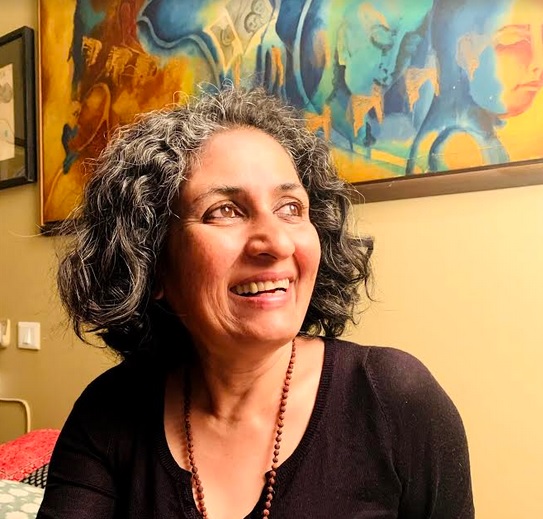Deeply in tune with a spiritual approach to art and life, artist Seema Kohli chats with Abir Pothi about love, Shakti, and conviction
Epic, magical, mesmerizing, surreal and infinitely intricate art that celebrates the feminine — this just about embodies the vast multi-disciplinary oeuvre of Delhi-based artist Seema Kohli, who has meticulously presented a stunning range of creative expression to the world for over three decades.
But when one marvels to Kohli that her work is fascinatingly complex, she simply says, “So is life!”
Born in 1960, Kohli has always considered herself an artist, she professes. She was painting right from her childhood. “It is what I express myself best in, and I feel it is easier for me to relate to people with my images. Even when I was very young, I have always been interested in stories, which continues to be the basis of all my work. One is either telling a story or listening to one and depicting it. Growing up in Delhi, I belong to a spiritually inclined family — both my parents, my grandfather… we were not religious per se, but believed in the Advaita philosophy, with the Hindu way of life. We did not have idols in the house, but there was always conversation, an inquiry on different faiths, cultures and traditions. We would talk and discuss a lot of different things — even as a child on the dining table, we had questions of God and atheism and all these queries that would be asked and responded to! It was a wonderful childhood.”
Kohli is a true-blue Delhiite. She was born in the national capital and happens to still stay today in the same area. She studied a Diploma in Applied Arts at South Delhi Polytechnic, before which she did a BA Honours in Philosophy at Miranda House. She says, “This, too, was fuelled by my interest as a seeker of spirituality and trying to understand different philosophies. I studied European philosophies, Greek mythology, and Indian lore and philosophies as well. This was interesting as I had heard several narratives while growing up, but I could approach them in an academic way here. It is probably also why so much of my work even today is research-based. I liked to read, travel, listen to the music, immerse myself completely in my subject, and sort of involve all my senses in the creation of the art — and then it flows. The medium may change, and the imagery changes accordingly, but things keep evolving a certain way.”
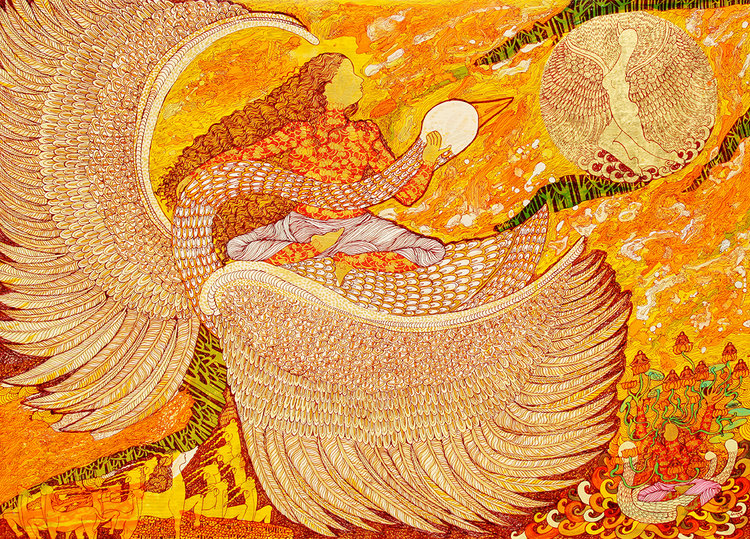
Kohli emphasizes, “I never had any extensive network when I started out, for that matter even now. I was not even from any regular, mainstream art college, or like the Baroda School of Art, or Shantiniketan, or the Delhi College of Art. I was from a polytechnic. But one has to keep working and have faith in oneself on this long path.”
The vivid art that emerges from this self-belief she held on to has been described as “a rich spiritual dialogue, layered with metaphysical connotations”. What is spirituality for Kohli? “It is all about the spirit. If somebody does not believe in it, I have no problem — but for me, it moves me beyond my body. We are connected to something — for instance, it is scientifically proven that we are connected to nature. So, what or who strings us together? Is it the consciousness? What is this consciousness that pervades everything? I have all these questions, and I like to answer them through my creative expression. I am a sensitive person, but I think I get so lost in my work that being creative takes over — at least for those hours, emotions get sidelined. I may wander into a different plane and space… it gets quite interesting! There was a time when much more used to bother me, but since art has taken over my life, it is much easier. Creative work takes over and moves you into a different emotional space.”
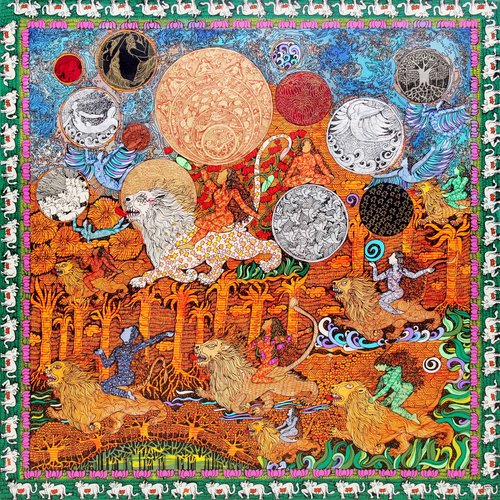
How then does Kohli approach her artwork vis-à-vis this spirituality? “I would like to describe it also as a habit, almost like learning to walk when you are a child. When you are just learning to walk, it takes you some months. You try to balance and keep falling… But there is a time when you finally start walking. The same is the case with speaking or when you start framing sentences. Now how does that happen? It takes time — how much time will it take? The thinking process is there, but you recognize how to weave that thinking process with your voice, and how you get it all out of your system. The same is the case with painting. One is weaving the imagery you are creating, and it is not something that is forced on you like a mandate, with a timeline, or like a project. And when it is not something forced, you start living it — constantly thinking about the subject that interests you, and it becomes a part of you and your existence and life. You may read about it, or listen to connected music, or visit certain spaces or associated archaeological sites, or meet people who may be responding to questions in probably the same way; or, they may have a completely different point of view! Essentially it is like ‘apne aap ko usme bhigona’ (immersing oneself in something), when you are constantly getting your mind and all your senses in tandem with the material that you are involved in. Painting is the medium for this, it is a language. My art, for me, is not about construction or the size of the canvas, and then seeing later what can be done with it. There is of course, a measure of thought in advance. Say if I want to do a large format work, I usually do my sketches done beforehand. I do rough sketches, as a practise but not especially of the work I am going to do. I inhabit the work I am involved in,” she says.
Kohli says her richly detailed and symbolically rife works start simply enough. “I begin with washes, a base. I say a small prayer to invoke the lord of luxuries. That is my way and was not taught to me. I create my own rituals and do my own thing. I walk my own path. I start to put silver leaf on the canvas. During this time, I also think of what I will be making. It is my time of contemplation and imagination. But most of my works are streamlined with my thought, whether it is the Tree of Life, Golden Womb, Project Home or Chimes of Freedom. They may all seem very different, but when I go into the depths and explain the concepts, it boils down to the same thing — I am you and you are me, there is no other. That is the crux of my work. What makes that other person me? It is through the manifestation of my art, the feminine. Because anything that is collaborating, moving, expanding, recreating and doing it positively is feminine. Only the feminine has the power to hold the womb, to create, reproduce.”
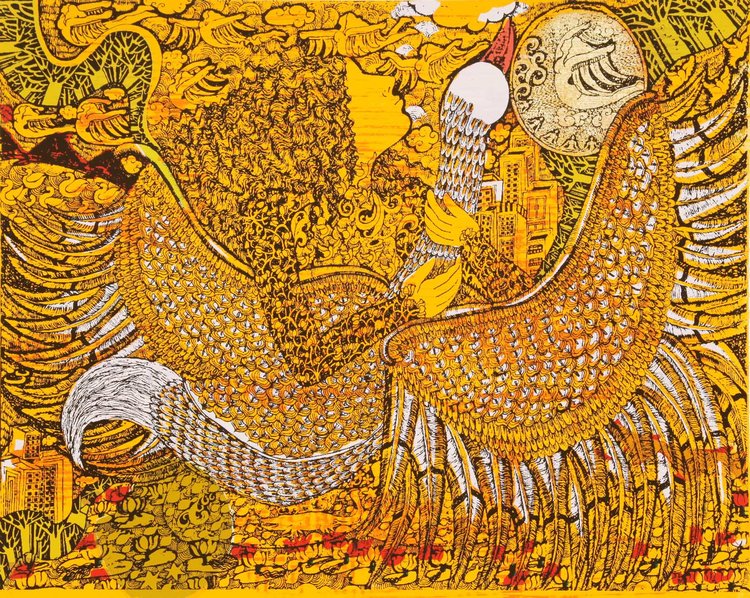
Which brings us to one of the foremost aspects of Kohli’s art — its feminine essence. While she has already broken the stereotype of male dominance in the world of art as a distinguished, authentic and bold contemporary female presence, Kohli also celebrates feminine form and energy in her art— “the source of the twin forces of creation and destruction”. It has been said that she “draws inspiration from mythology, philosophy, iconography and literature and creates stories that reclaim the lost feminine narrative of cultural history”.
But she gently asserts that there is no gender barrier involved in her work. “It is the feminine energy that I talk about. And it transcends the feminine or female form. I am talking about a space without gender or the outer garb. What remains is the feminine. The feminine link, which we call Shakti, pervades everything. It’s the manifestation of Shakti that we see everything around SarvaKhalvitam Maya — it is a heavy word. At the end of the day, let us just say that the idea of the feminine pervades my work.”
Asked about interpretations of depiction of feminine sexuality in her work as ‘erotic art’, she sharply says, “These are words that are exotic, make headlines, nice to use, but what do you really mean by erotica? How do artists have an expression that is their own? There will always be someone trying to pull you down by misinterpretation.”
What about ‘spiritual art’? “There is no distinction in art according to me, art is simply art. It can take you to different states of mind, anger, distraught, morbid, happy, surreal or spiritual. Everything is connected and has been worked upon in so many layers of your subconscious. The mind is not pure consciousness, but a reflection of it, which we call antahkaran — one that is a part of your being, carrying the many layers of birth and rebirth. Passion, intuition and synchronicity are deeply related. But for me, ultimately, it is love is what moves everything. It is the most important thing. Love only can translate into passion, but it is something that is most essential. I am a die-hard romantic. I could look at a tree and fall in love with it. What is love, after all? I don’t know how to word it, but I feel it connects you with another — when you see yourself in the other. Because you love yourself the most. There is no one who does not, even if they say it. If you are honest, you will see that it is true. The moment you try to see yourself in others, that is love — which is divine. It’s beautifully expressed in the Upanishads as TatvaMasi — I art thou,” she says, adding, “Also, so many people do not understand, or underestimate art. But it too is like love — you give (time, effort, everything) and then you get. Any creative space is a very demanding, mor so as a profession, if you call it that. It takes your life and wants everything. In each moment of your life, if you’re not living and breathing art, then there is something you are lacking, and it will show in what you do.”
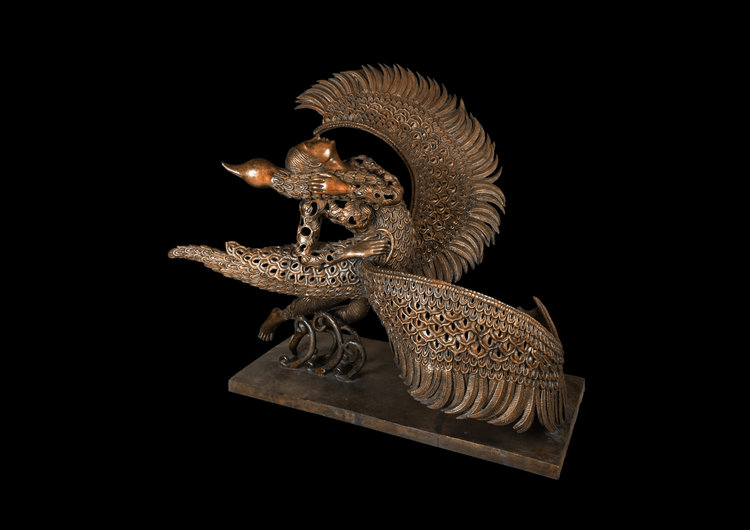
In this way, embracing art not as work but as a way of life makes it ‘sahej’, makes it flow easily, feels Kohli. Her formidable body of work certainly bears testament to the fact. In 36-odd years, Kohli has harnessed a unique vocabulary of her own in her eclectic repertoire, manifested in painting, sculpture, experiential installation performances, poetry and more.
A winner of the Lalit Kala Akademi National Award for Women in 2007, her 20-ft-high bronze sculpture Tree of Life is displayed at the prestigious Supreme Court’s new wing; in New Delhi, her murals are proudly displayed at the T3 Delhi International Airport, as well as Mumbai International/ Domestic Airport. Her artworks find a special place in collections of the National Gallery Of Modern Art, Bangalore, Melinda Bill Gates Foundation, Rubin’s Museum, MOSA-Brussels and Kochi Museum of Arts. She has helmed over 30 solo shows in London, New York, Dubai, Venice, Brussels, Singapore, Delhi, Mumbai, Hyderabad and more, and taken part in renowned International Biennales (Venice, Shanghai, India), as well as art fairs (Hong Kong, Basel, Beijing, Madrid, India).
And yet, she remains full of humility. “An artist is young when they are 60,” she smiles, when asked what she would tell young, emerging artists as advice from her experience. “The conviction with which you work in all the years you are inspired is what matters. I don’t believe in titles of senior and junior. It is about the conviction one holds, with which one has worked — not age. How long have you spent with an idea, or thought or concept, how deep is your involvement? How many works have you created that talk with the same intensity, same conviction, with the same energy and thought? That is the youth of your artwork, not of your age or body.”
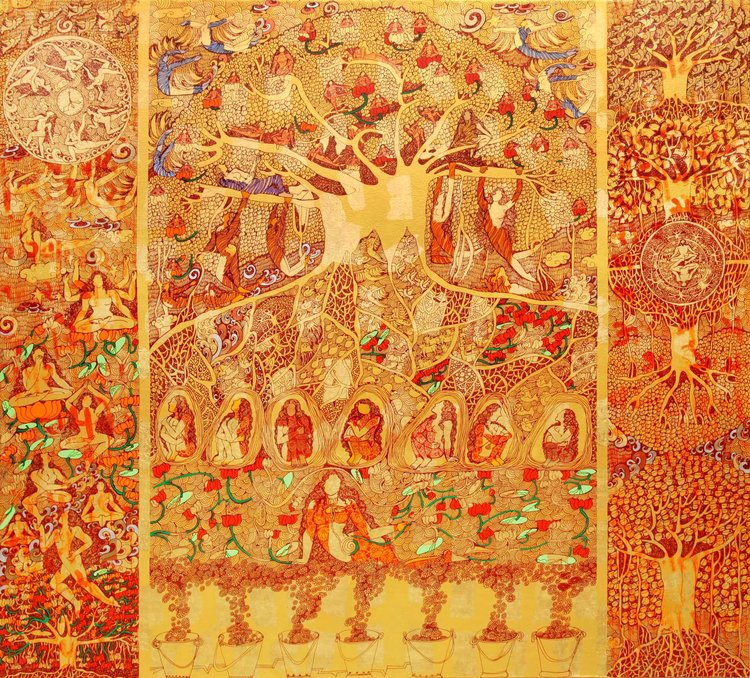
She adds, “No artist can be helped or advised for creativity. They have their own path and cannot walk anyone else’s, with their own process and thoughts. We could explain our way of life, but at the end, we choose what we want to, as each artist is so distinct. I would tell all young artists to actually walk and choose their own paths. The more difficult the path, the longer, more enjoyable the journey is. For me, it is an unending journey. It is not as if something is done, and I don’t need to do more. This is not the way an artist thinks. We should all try to create our own ways and mediums to express ourselves, as each medium is imbued with so, so many possibilities. I am inspired by life and its nuances.”


